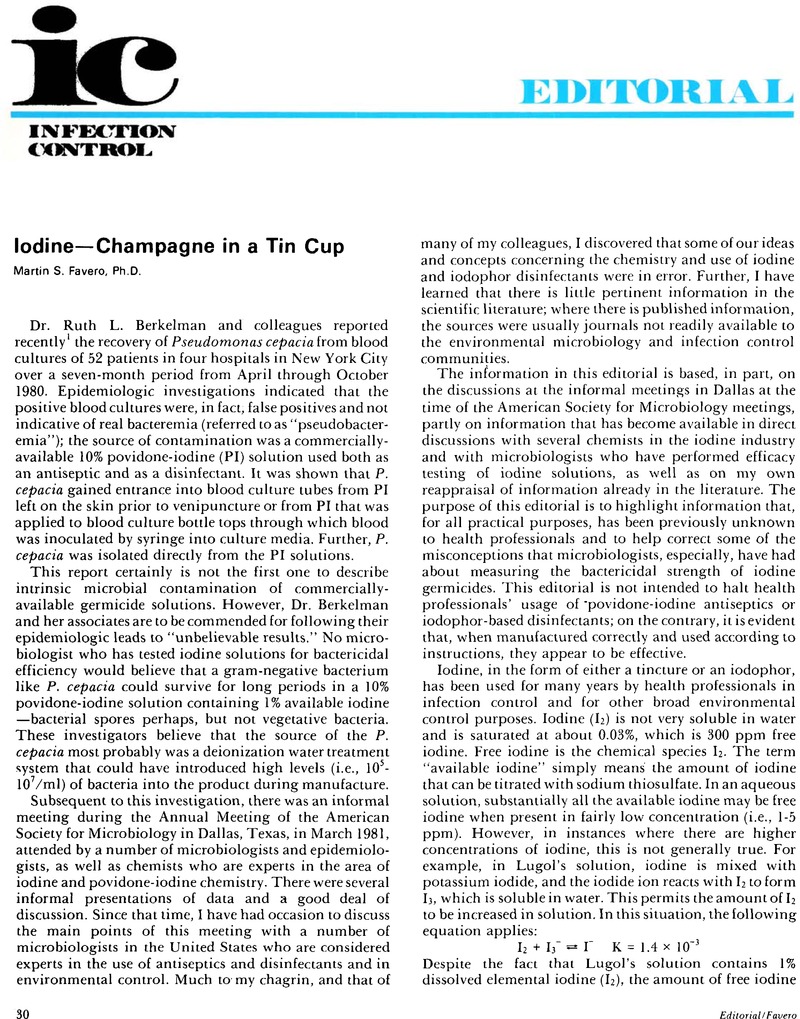Crossref Citations
This article has been cited by the following publications. This list is generated based on data provided by
Crossref.
Parrott, PatriciaL.
Whitworth, ElizabethN.
Terry, PamelaM.
Frawley, LorettaW.
Coble, RebeccaS.
Wachsmuth, I.Kaye
and
Mcgowan, JohnE.
1982.
PSEUDOMONAS AERUGINOSA PERITONITIS ASSOCIATED WITH CONTAMINATED POLOXAMER-IODINE SOLUTION.
The Lancet,
Vol. 320,
Issue. 8300,
p.
683.
1983.
Cleaning, disinfection, and sterilization of hospital equipment.
American Journal of Infection Control,
Vol. 11,
Issue. 3,
p.
119.
Pankey, J.W.
Eberhart, R.J.
Cuming, A.L.
Daggett, R.D.
Farnsworth, R.J.
and
McDuff, C.K.
1984.
Uptake on Postmilking Teat Antisepsis.
Journal of Dairy Science,
Vol. 67,
Issue. 6,
p.
1336.
Sebben, Jack E.
1984.
Reply.
Journal of the American Academy of Dermatology,
Vol. 10,
Issue. 6,
p.
1065.
Werner, H.-P.
1984.
PVP-Jod in der operativen Medizin.
p.
27.
Favero, M S
1984.
Whirlpool spa-associated infections: are we really in hot water?.
American Journal of Public Health,
Vol. 74,
Issue. 7,
p.
653.
Sebben, Jack E.
1984.
Sterilization and care of surgical instruments and supplies.
Journal of the American Academy of Dermatology,
Vol. 11,
Issue. 3,
p.
381.
Anderson, R L
Berkelman, R L
Mackel, D C
Davis, B J
Holland, B W
and
Martone, W J
1984.
Investigations into the survival of Pseudomonas aeruginosa in poloxamer-iodine.
Applied and Environmental Microbiology,
Vol. 47,
Issue. 4,
p.
757.
Haley, C E
Marling-Cason, M
Smith, J W
Luby, J P
and
Mackowiak, P A
1985.
Bactericidal activity of antiseptics against methicillin-resistant Staphylococcus aureus.
Journal of Clinical Microbiology,
Vol. 21,
Issue. 6,
p.
991.
Todd, Betsy
1986.
Using antiseptics effectively.
Geriatric Nursing,
Vol. 7,
Issue. 2,
p.
105.
Furman, K. I.
Doehring, R. O.
Galasko, G. T. F.
Kleiman, M. S.
and
Rudnick, J.
1986.
Frontiers in Peritoneal Dialysis.
p.
619.
Keith, L. G.
Bailey, R.
and
Method, M.
1986.
The Ljubljana IUDS: further observations on surface morphology.
Advances in Contraception,
Vol. 2,
Issue. 1,
p.
37.
Mills, Shannon E.
Lauderdale, Patricia W.
and
Mayhew, Robert B.
1986.
Reduction of microbial contamination in dental units with povidone-iodine 10%.
The Journal of the American Dental Association,
Vol. 113,
Issue. 2,
p.
280.
Russell, A.D.
Hammond, S.A.
and
Morgan, J.R.
1986.
Bacterial resistance to antiseptics and disinfectants.
Journal of Hospital Infection,
Vol. 7,
Issue. 3,
p.
213.
Larson, Elaine
1987.
Draft guideline for use of topical antimicrobial agents.
American Journal of Infection Control,
Vol. 15,
Issue. 6,
p.
A25.
Larson, Elaine
1988.
Guideline for use of topical antimicrobial agents.
American Journal of Infection Control,
Vol. 16,
Issue. 6,
p.
253.
Tranæus, Anders
Heimbürger, Olof
and
Lindholm, Bengt
1988.
Peritonitis during Continuous Ambulatory Peritoneal Dialysis (CAPD): Risk Factors, Clinical Severity, and Pathogenetic Aspects.
Peritoneal Dialysis International: Journal of the International Society for Peritoneal Dialysis,
Vol. 8,
Issue. 4,
p.
253.
Anderson, Roger L.
1989.
Iodophor Antiseptics: Intrinsic Microbial Contamination with Resistant Bacteria.
Infection Control and Hospital Epidemiology,
Vol. 10,
Issue. 10,
p.
443.
Lee Ford-Jones, E.
1989.
Topical antiseptics.
Clinics in Dermatology,
Vol. 7,
Issue. 3,
p.
142.
Rutala, William A.
1990.
APIC guideline for selection and use of disinfectants.
American Journal of Infection Control,
Vol. 18,
Issue. 2,
p.
99.

